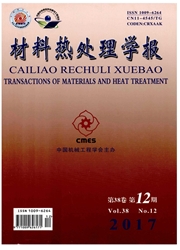

 中文摘要:
中文摘要:
通过室温力学性能测试,光学显微镜、扫描电镜和透射电镜研究了淬火速率对AlZnMgCu(Zr)合金断裂行为的影响。结果表明:含Zr小于0.1%合金随着淬火速率的降低,由穿晶破断和沿晶开裂的混合型断裂逐渐转变成沿晶断裂;其主要原因是淬火速率降低使晶界无沉淀析出带(PFZ)宽化。含Zr大于等于0.1%的合金随着淬火速率的降低由穿晶破断为主的断裂逐渐转变成沿晶开裂和穿晶剪切的混合型断裂;沿晶断裂的产生主要是由于晶界无沉淀析出带宽化;穿晶剪切主要是由于慢速淬火过程中晶粒内部析出了大量粗大的η平衡相。
 英文摘要:
英文摘要:
The effect of quench rates on the fracture behavior of AlZnMgCu (Zr) alloy was investigated by ambient tensile testing, optical microscope, scanning electron microscopy and transmission electron microscopy. The results show that intergranular fracture prevails as quench rates decrease for the alloy with Zr 〈 0.1%, which is primarily attributed to the increased grain boundary precipitate-free-zone(PFZ) width. For the alloy with Zr≥0.1% the failure mode is changed from predominant transgranular void growth to intergranular and transgranualr shear fracture with decreasing the quench rates. The intergranular fracture is primarily caused by wide grain boundary precipitates free zone, while transgranular shear fracture is due to coarse equilibrium η particles in the grains induced by slow quench.
 同期刊论文项目
同期刊论文项目
 同项目期刊论文
同项目期刊论文
 期刊信息
期刊信息
